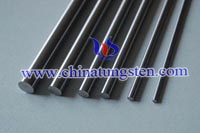Different annealing temperatures, tensile
fracture morphology of TZM alloy is not the same. When annealing temperature is
850 ℃, the tensile
fracture of TZM alloy is mainly transgranular fracture. There is a significant
cleavage step on the fracture. And there are a lot of holes in fracture grain
boundary. Besides, these holes are formed crack sources in the stretching
process which causes alloy break by interconnected. Annealed at 1000 ℃, the fracture has obvious
river-like pattern and cleavage step. When the cracks expansion will connect
with dislocation and therefore will generate cleavage step. Meanwhile, the
alloy before breaking through a lot of strain, so there has been a lot of tearing
ridge on cleavage surface. When the annealing temperature is 1150 ℃, the fracture characteristics is
similar to 1000 ℃ fracture characteristics,
but the degree of cleavage fracture has improved, so the breaking plastic of
alloy also increased.
Recrystallization temperature of TZM alloy
is about 1200 ℃, when the
annealing temperature exceeds the recrystallization temperature, the alloy has coarse
grains, the fracture surface is relatively flat. The fracture is mainly
transgranular fracture and ductile fracture which is mean plastic of alloy has
been further increase. But there have been many irregularities particles and
pits in the alloy and there are enhanced phase precipitate in local area. This
shows the high annealing temperature weakened dispersion strengthen and have a
certain influence on the mechanical properties of the alloys. Therefore, the
annealing temperature should be controlled below the recrystallization
temperature of TZM alloy.



